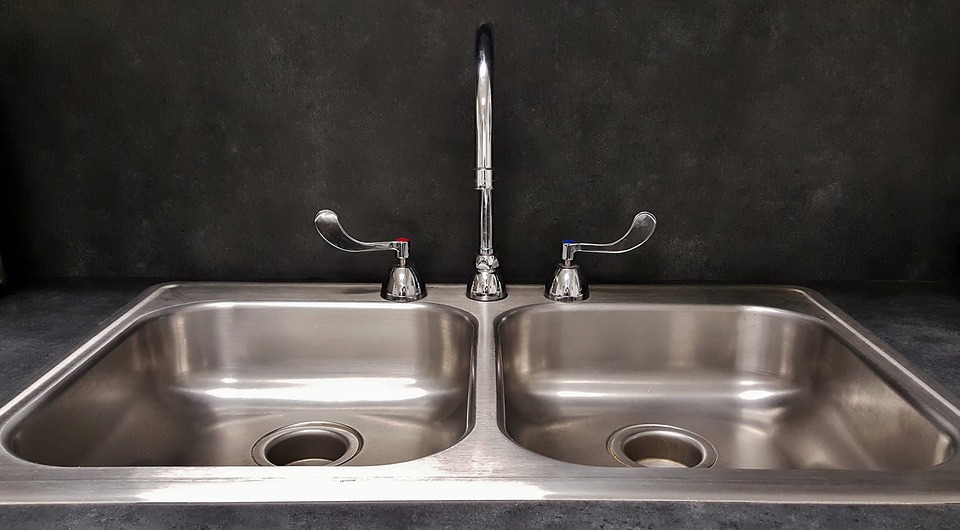Sink
According to The Building Regulations Approved Document G: Sanitation, hot water safety and water efficiency a sink is a ‘sanitary appliance’. Sanitary appliances collect and remove water and other waste matter. They are generally grouped into two categories: soil appliances and waste water appliances. A sink is categorised as a waste water appliance. The Scottish Building Standards, Part I. Technical Handbook – Domestic, Appendix A Defined Terms, defines a sink as a type of sanitary facility.
Sinks and other sanitary appliances were traditionally manufactured from porcelain (a ceramic material made from clay that might be described as 'vitreous china' when coated with enamel). Sinks made from this material might be referred to as ceramic, porcelain or china sanitary ware, and are often white. They are also made from a wide range of other materials, including metals, acrylics, glass, enamelled cast iron, stainless steel and treated plastic.
There are many different types of sinks, including: bathroom sinks, utility sinks, kitchen sinks, laboratory sinks, commercial/industrial sinks, medical/surgical sinks, wash troughs and so on.
Generally, sinks consist of a bowl or basin (to hold the water), taps (to control the flow of water), a drain connected to the plumbing systems (to remove the used water) and some sort of support component (possibly in the form of a cabinet, a pedestal, a countertop and so on). There are also freestanding sinks that are supported by legs.
See also: Basin.
NB AR5 Climate Change 2014: Impacts, Adaptation, and Vulnerability, Glossary, published by the Intergovernmental Panel on Climate Change (IPCC) defines a sink as: ‘Any process, activity, or mechanism that removes a greenhouse gas, an aerosol, or a precursor of a greenhouse gas or aerosol from the atmosphere.’
Global Warming of 1.5 ºC, Glossary, published by the Intergovernmental Panel on Climate Change (IPCC) in 2018, defines a sink as: ‘A reservoir (natural or human, in soil, ocean, and plants) where a greenhouse gas, an aerosol or a precursor of a greenhouse gas is stored. Note that UNFCCC Article 1.8 refers to a sink as any process, activity or mechanism which removes a greenhouse gas, an aerosol or a precursor of a greenhouse gas from the atmosphere.’
[edit] Related articles on Designing Buildings
- Approved Document G.
- Basin.
- Bath.
- Bidet.
- Lavatory.
- Sanitary accommodation.
- Sanitary pipework.
- Sanitaryware.
- Sink v basin.
- Solid surface wash trough.
- Types of sanitary appliances.
- Waste water.
[edit] External resources
Featured articles and news
RTPI leader to become new CIOB Chief Executive Officer
Dr Victoria Hills MRTPI, FICE to take over after Caroline Gumble’s departure.
Social and affordable housing, a long term plan for delivery
The “Delivering a Decade of Renewal for Social and Affordable Housing” strategy sets out future path.
A change to adoptive architecture
Effects of global weather warming on architectural detailing, material choice and human interaction.
The proposed publicly owned and backed subsidiary of Homes England, to facilitate new homes.
How big is the problem and what can we do to mitigate the effects?
Overheating guidance and tools for building designers
A number of cool guides to help with the heat.
The UK's Modern Industrial Strategy: A 10 year plan
Previous consultation criticism, current key elements and general support with some persisting reservations.
Building Safety Regulator reforms
New roles, new staff and a new fast track service pave the way for a single construction regulator.
Architectural Technologist CPDs and Communications
CIAT CPD… and how you can do it!
Cooling centres and cool spaces
Managing extreme heat in cities by directing the public to places for heat stress relief and water sources.
Winter gardens: A brief history and warm variations
Extending the season with glass in different forms and terms.
Restoring Great Yarmouth's Winter Gardens
Transforming one of the least sustainable constructions imaginable.
Construction Skills Mission Board launch sector drive
Newly formed government and industry collaboration set strategy for recruiting an additional 100,000 construction workers a year.
New Architects Code comes into effect in September 2025
ARB Architects Code of Conduct and Practice available with ongoing consultation regarding guidance.
Welsh Skills Body (Medr) launches ambitious plan
The new skills body brings together funding and regulation of tertiary education and research for the devolved nation.
Paul Gandy FCIOB announced as next CIOB President
Former Tilbury Douglas CEO takes helm.
UK Infrastructure: A 10 Year Strategy. In brief with reactions
With the National Infrastructure and Service Transformation Authority (NISTA).























